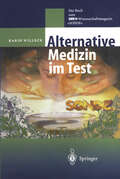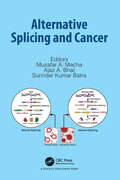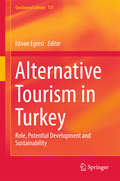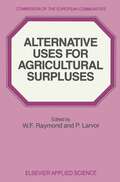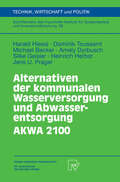- Table View
- List View
Alternative Logics. Do Sciences Need Them?
by Paul A. WeingartnerInitially proposed as rivals of classical logic, alternative logics have become increasingly important in sciences such as quantum physics, computer science, and artificial intelligence. The contributions collected here address the question whether the usage of logic in the sciences, especially in modern physics, requires a deviation from classical mathematical logic. The articles in the first part of the book set the scene by describing the context and the dilemma when applying logic in science. In Part II the authors offer several logics that deviate in different ways. The twelve papers in Part III investigate in detail specific aspects such as quantum logic, quantum computation, computer-science considerations, praxic logic, and quantum probability. The monograph provides a succinct picture of recent research in alternative logics as they have been developed for applications in the sciences.
Alternative Medicine Interventions for COVID-19
by Muhammad Zia-Ul-Haq May Nasser Bin-Jumah Sarah I. Alothman Hanan A. HenidiThis research volume examines the available alternative, complementary, pharmaceutical and vaccine methods for treating, mitigating, or preventing COVID-19. Coverage includes traditional Chinese medicine, herbal remedies, nutraceutical/dietary options, and drug/vaccine therapies. All the methods discussed will be critically examined to provide readers with a full, unbiased overview that includes pros/cons of each method. While the nature of COVID-19 is still being studied, and new research and theories are being published daily, this book endeavors to provide readers with a comprehensive summary of current research on alternative and mainstream treatment and prevention methods.
Alternative Medicines for Diabetes Management: Advances in Pharmacognosy and Medicinal Chemistry (Medicinal Plants and Natural Products for Human Health)
by Varma H. Rambaran Nalini K. SinghApart from diet and exercise, the strategic use of different classes of prescribed or non-prescribed xenobiotic compounds for the restoration of euglycemic levels in the body is well known. The ongoing rivalry between the recommended usage of allopathic medicines versus ayurvedic remedies has encouraged many researchers to focus their studies on thoroughly isolating and characterizing the extracts from different parts of plants and then evaluating their relative activities via in vitro, in vivo and in some cases clinical studies. Alternative Medicines for Diabetes Management: Advances in Pharmacognosy and Medicinal Chemistry provides a holistic view of all oral therapies for diabetes mellitus that are available to the public by removing the silos and stigmas that are associated with both allopathic and ayurvedic medicines. Additional Features Include: Highlights the potential role of dietary and medicinal plant materials in the prevention, treatment, and control of diabetes and its complications. Educates readers on the benefits and shortcomings of the various present and potential oral therapies for diabetes mellitus. Allows quick identification and retrieval of material by researchers learning the efficacy, associated dosage and toxicity of each of the classes of compounds. Presents the history, nomenclature, mechanisms of action and shortcomings for each of the various sub-classes of allopathic therapeutants for diabetes mellitus and then introduces ayurvedic medicines. Section C discusses various metallopharmaceuticals and provides a holistic view of all available and potential therapies for the disease.
Alternative Medicines for Diabetes Management: Advances in Pharmacognosy and Medicinal Chemistry (Medicinal Plants and Natural Products for Human Health)
by Varma H. Rambaran Nalini K. SinghApart from diet and exercise, the strategic use of different classes of prescribed or non-prescribed xenobiotic compounds for the restoration of euglycemic levels in the body is well known. The ongoing rivalry between the recommended usage of allopathic medicines versus ayurvedic remedies has encouraged many researchers to focus their studies on thoroughly isolating and characterizing the extracts from different parts of plants and then evaluating their relative activities via in vitro, in vivo and in some cases clinical studies. Alternative Medicines for Diabetes Management: Advances in Pharmacognosy and Medicinal Chemistry provides a holistic view of all oral therapies for diabetes mellitus that are available to the public by removing the silos and stigmas that are associated with both allopathic and ayurvedic medicines. Additional Features Include: Highlights the potential role of dietary and medicinal plant materials in the prevention, treatment, and control of diabetes and its complications. Educates readers on the benefits and shortcomings of the various present and potential oral therapies for diabetes mellitus. Allows quick identification and retrieval of material by researchers learning the efficacy, associated dosage and toxicity of each of the classes of compounds. Presents the history, nomenclature, mechanisms of action and shortcomings for each of the various sub-classes of allopathic therapeutants for diabetes mellitus and then introduces ayurvedic medicines. Section C discusses various metallopharmaceuticals and provides a holistic view of all available and potential therapies for the disease.
Alternative Medizin im Test: Das Buch zum SWR ?-Wissenschaftsmagazin „SONDE“
by Karin WilleckWelche alternativen Heilmethoden gibt es? Wie wirken sie und wieviel kostet die Behandlung? Das sind Fragen, die Ärzten und Therapeuten zunehmend gestellt werden.Immer mehr Patienten erwarten umfassende Information und kompetente Beratung zu Nutzen, Risiken und Qualität von Naturheilverfahren und alternativen Therapien.Alternative Medizin im Test ist ein fundierter Ratgeber, der Ihnen 21 alternative Heilmethoden in einem kompakten, informativen Überblick vorstellt: neutral, sachlich und kritisch.Das Buch basiert auf der gleichnamigen Fernsehreihe im Wissenschaftsmagazin Sonde des SWR. Das Expertengremium der Sendereihe beurteilt und bewertet alle vorgestellten Heilmethoden, unter anderem Homöopathie, Ayurveda, Bioresonanztherapie, Colonhydrotherapie, Aromatherapie und Mikrobiologische Therapie.Die Experten beschreiben ausführlich jedes Verfahren mit seinen Anwendungsgebieten und den Behandlungskosten. Bewertet werden die Methode, die wissenschaftlichen Nachweise, das Ausbildungsniveau und die möglichen Risiken.Zusätzlich enthält das Buch einen umfassenden Adressenteil und viele nützliche Tips für den Umgang mit der Krankenkasse.Eine kompetente Informationsquelle, die Ihnen schnell griffbereit solide Bewertungskriterien und praktische Entscheidungshilfen bietet.
Alternative pre-mRNA Splicing: Theory and Protocols
by Stefan Stamm Chris Smith Reinhard L Hrmann Reinhard L Uuml Hrmann Reinhard Lührmann Reinhard LhrmannThis book was written for graduate and medical students, as well as clinicians and postdoctoral researchers. It describes the theory of alternative pre-mRNA splicing in twelve introductory chapters and then introduces protocols and their theoretical background relevant for experimental research. These 43 practical chapters cover: Basic methods, Detection of splicing events, Analysis of alternative pre-mRNA splicing in vitro and in vivo, Manipulation of splicing events, and Bioinformatic analysis of alternative splicing. A theoretical introduction and practical guide for molecular biologists, geneticists,clinicians and every researcher interested in alternative splicing. Website: www.wiley-vch.de/home/splicing
Alternative pre-mRNA Splicing: Theory and Protocols
by Stefan Stamm Chris Smith Reinhard LührmannThis book was written for graduate and medical students, as well as clinicians and postdoctoral researchers. It describes the theory of alternative pre-mRNA splicing in twelve introductory chapters and then introduces protocols and their theoretical background relevant for experimental research. These 43 practical chapters cover: Basic methods, Detection of splicing events, Analysis of alternative pre-mRNA splicing in vitro and in vivo, Manipulation of splicing events, and Bioinformatic analysis of alternative splicing. A theoretical introduction and practical guide for molecular biologists, geneticists,clinicians and every researcher interested in alternative splicing. Website: www.wiley-vch.de/home/splicing
Alternative Protein Sources in Aquaculture Diets
by Chhorn Lim Carl D. Webster Cheng-Sheng LeeA unique resource that describes the ingredients included in an aquaculture diet, species profiles, processing methods, impacts to environment and industry, and more. Aquaculture is and will remain a major food producing sector in the future. To become more efficient and successful in the aquaculture industry, operations need to provide good nutrition. Alternative Protein Sources in Aquaculture Diets is a unique source describing the ingredients included in fish and crustacean diets, their nutrient compositions, species profiles, suitability for species, processing methods, and impacts of alternative ingredients on the environment and to the aquaculture industry. World-renowned nutritionists and feed technologists explore practical ways for the aquaculture industry to expand and remain competitive, and discuss ways to develop less expensive alternative sources or protein. Diet costs take up a huge chunk of operating expenditures, with fish meal being one of the most expensive ingredients in the aquaculture diet. Alternative Protein Sources in Aquaculture Diets provides detailed knowledge on the use of alternative plant and animal protein sources, offering opportunities to either partially or completely replace fish meal. This comprehensive, up-to-date text discusses the most widely used ingredients as well as various previously under-utilized ingredients which could be of significant potential in the future. The book is extensively referenced and includes numerous helpful tables to clearly present data. Topics discussed in Alternative Protein Sources in Aquaculture Diets (for finfish and crustacean species) include: • farmed fish diet requirements • reduction of waste through diet formulation • poultry by-product meal • meat packing by-products • soybean protein foodstuffs • cottonseed meal • lupins • unconventional plant protein supplements.
Alternative Protein Sources in Aquaculture Diets
A unique resource that describes the ingredients included in an aquaculture diet, species profiles, processing methods, impacts to environment and industry, and more. Aquaculture is and will remain a major food producing sector in the future. To become more efficient and successful in the aquaculture industry, operations need to provide good nutrition. Alternative Protein Sources in Aquaculture Diets is a unique source describing the ingredients included in fish and crustacean diets, their nutrient compositions, species profiles, suitability for species, processing methods, and impacts of alternative ingredients on the environment and to the aquaculture industry. World-renowned nutritionists and feed technologists explore practical ways for the aquaculture industry to expand and remain competitive, and discuss ways to develop less expensive alternative sources or protein. Diet costs take up a huge chunk of operating expenditures, with fish meal being one of the most expensive ingredients in the aquaculture diet. Alternative Protein Sources in Aquaculture Diets provides detailed knowledge on the use of alternative plant and animal protein sources, offering opportunities to either partially or completely replace fish meal. This comprehensive, up-to-date text discusses the most widely used ingredients as well as various previously under-utilized ingredients which could be of significant potential in the future. The book is extensively referenced and includes numerous helpful tables to clearly present data. Topics discussed in Alternative Protein Sources in Aquaculture Diets (for finfish and crustacean species) include: • farmed fish diet requirements • reduction of waste through diet formulation • poultry by-product meal • meat packing by-products • soybean protein foodstuffs • cottonseed meal • lupins • unconventional plant protein supplements.
Alternative Respiratory Pathways in Higher Plants
by Kapuganti Jagadis Gupta Luis A. J. Mur Bhagyalakshmi NeelwarneRapid developments in molecular and systems biology techniques have allowed researchers to unravel many new mechanisms through which plant cells switch over to alternative respiratory pathways.This book is a unique compendium of how and why higher plants evolved alternative respiratory metabolism. It offers a comprehensive review of current research in the biochemistry, physiology, classification and regulation of plant alternative respiratory pathways, from alternative oxidase diversity to functional marker development. The resource provides a broad range of perspectives on the applications of plant respiratory physiology, and suggests brand new areas of research.Other key features: written by an international team of reputed plant physiologists, known for their pioneering contributions to the knowledge of regular and alternative respiratory metabolism in higher plants includes step-by-step protocols for key molecular and imaging techniques advises on regulatory options for managing crop yields, food quality and environment for crop improvement and enhanced food security covers special pathways which are of key relevance in agriculture, particularly in plant post-harvest commodities Primarily for plant physiologists and plant biologists, this authoritative compendium will also be of great value topostdoctoral researchers working on plant respiration, as well as to graduate and postgraduate students and university staff in Plant Science. It is a useful resource for corporate and private firms involved in developing functional markers for breeding programs and controlling respiration for the prevention of post-harvest losses in fruit, vegetables, cut flowers and tubers.
Alternative Respiratory Pathways in Higher Plants
by Bhagyalakshmi Neelwarne Luis A.J. Mur Kapuganti Jagadis GuptaRapid developments in molecular and systems biology techniques have allowed researchers to unravel many new mechanisms through which plant cells switch over to alternative respiratory pathways.This book is a unique compendium of how and why higher plants evolved alternative respiratory metabolism. It offers a comprehensive review of current research in the biochemistry, physiology, classification and regulation of plant alternative respiratory pathways, from alternative oxidase diversity to functional marker development. The resource provides a broad range of perspectives on the applications of plant respiratory physiology, and suggests brand new areas of research.Other key features: written by an international team of reputed plant physiologists, known for their pioneering contributions to the knowledge of regular and alternative respiratory metabolism in higher plants includes step-by-step protocols for key molecular and imaging techniques advises on regulatory options for managing crop yields, food quality and environment for crop improvement and enhanced food security covers special pathways which are of key relevance in agriculture, particularly in plant post-harvest commodities Primarily for plant physiologists and plant biologists, this authoritative compendium will also be of great value topostdoctoral researchers working on plant respiration, as well as to graduate and postgraduate students and university staff in Plant Science. It is a useful resource for corporate and private firms involved in developing functional markers for breeding programs and controlling respiration for the prevention of post-harvest losses in fruit, vegetables, cut flowers and tubers.
Alternative Routes to Oil Structuring (SpringerBriefs in Food, Health, and Nutrition)
by Ashok R. PatelThis Springer Brief gives an overview of recent research conducted in the area of oil structuring starting with a detailed introduction on oleogelation and properties of food-approved building blocks followed by the discussion of some illustrative examples to explain the processing steps required for creating oleogels, advanced characterization (rheological, thermal and microstructural) and some potential edible applications of oleogels. The book w concludes with a section summarizing the general guidelines on the properties of oleogels and practically of approach with regards to the specific category of building blocks used for structuring. The text also lists some unresolved challenges that need to be addressed in order to fully exploit oleogelation for future food product development.The functional application of liquid oils in food product development is mostly accomplished by structuring them into soft, plastic-like materials. This structuring of oil is traditionally based on the fat crystal network formed by high melting triacylglycerol (TAG) molecules that are rich in trans and/or saturated fatty acids. Currently, due to the factors such as the requirement for trans- and saturated fat-free food products, sustainable manufacturing and ethical trade practices, the research in the area of identifying alternative routes to oil structuring (in the absence of trans and saturated fats) has been regarded as a ‘hot topic’ in the bio-scientific community. Oleogelation (gelling of liquid oil in absence of crystallizable TAGs) is one such alternative, which has recently attracted tremendous attention from researchers and industrial scientists working in the domain of food product development. The possibility of creating structured gels that contain a large amount of liquid oil (usually above 90 wt%) opens up many possibilities to develop food products with better nutritional profiles.
Alternative Solvents for Natural Products Extraction (Green Chemistry and Sustainable Technology)
by Farid Chemat Maryline Abert VianThis book presents a complete picture of the current state-of-the-art in alternative and green solvents used for laboratory and industrial natural product extraction in terms of the latest innovations, original methods and safe products. It provides the necessary theoretical background and details on extraction, techniques, mechanisms, protocols, industrial applications, safety precautions and environmental impacts. This book is aimed at professionals from industry, academicians engaged in extraction engineering or natural product chemistry research, and graduate level students. The individual chapters complement one another, were written by respected international researchers and recognized professionals from the industry, and address the latest efforts in the field. It is also the first sourcebook to focus on the rapid developments in this field.
Alternative Splicing: Methods and Protocols (Methods in Molecular Biology #2537)
by Peter Scheiffele Oriane MaugerThis detailed volume collects commonly used and cutting-edge methods to analyze alternative splicing, a key step in gene regulation. After an introduction of the alternative splicing mechanism and its targeting for therapeutic strategies, the book continues with techniques for analyzing alternative splicing profiles in complex biological systems, visualizing and localizing alternative spliced transcripts with cellular and sub-cellular resolution, probing regulators of alternative splicing, as well as assessing the functional consequences of alternative splicing. Written for the highly successful Methods in Molecular Biology series, chapters include introduction to their respective topics, lists of the necessary materials and reagents, step-by-step, reproducible protocols, and tips on troubleshooting and avoiding known pitfalls. Authoritative and practical, Alternative Splicing: Methods and Protocols serves as an ideal guide for both RNA aficionados that want to implement novel approaches in their labs and novices undertaking alternative splicing projects.
Alternative Splicing and Cancer
by Muzafar A. Macha Ajaz A. Bhat Surinder Kumar BatraThis book Alternative Splicing and Cancer explores the crucial role alternative splicing, a post-transcriptional process, plays in human health and diseases, particularly cancer. Diving deep into the complexities of gene expression and protein diversity, the book illuminates how abnormal splicing contributes to aggressive tumor formation, affecting cellular functions such as proliferation, survival, and immune evasion. With a focus on understanding molecular mechanisms, this book unravels potential diagnostic and prognostic targets, opening doors for enhanced anti-cancer treatment efficacy. An indispensable resource for anyone intrigued by the interplay between gene splicing and cancer biology, it paves the way towards innovative therapeutic strategies.
Alternative Splicing and Cancer
This book Alternative Splicing and Cancer explores the crucial role alternative splicing, a post-transcriptional process, plays in human health and diseases, particularly cancer. Diving deep into the complexities of gene expression and protein diversity, the book illuminates how abnormal splicing contributes to aggressive tumor formation, affecting cellular functions such as proliferation, survival, and immune evasion. With a focus on understanding molecular mechanisms, this book unravels potential diagnostic and prognostic targets, opening doors for enhanced anti-cancer treatment efficacy. An indispensable resource for anyone intrigued by the interplay between gene splicing and cancer biology, it paves the way towards innovative therapeutic strategies.
Alternative Splicing and Disease (Progress in Molecular and Subcellular Biology #44)
by Philippe JeanteurSplicing of primary RNA transcript is a quasi-systematic step of gene expression in higher organisms. This is the first book to highlight the medical implications, i.e. diseases, caused by alternative splicing. Alternative splicing not only vastly increases protein diversity but also offers numerous opportunities for aberrant splicing events with pathological consequences. The book also outlines possible targets for therapy.
Alternative Sweet and Supersweet Principles: Natural Sweeteners and Plants
by Ram Snehi DwivediThis book compiles the latest information on different kinds of natural, plant-based super sweeteners. A book on alternative, natural super sweeteners is extremely timely and useful, especially, in light of the decreasing cultivable area, ever increasing demand for sucrose, and the well identified ills of sugar consumption. Every year more than 5.0 million people die due to diabetes and diabetes-associated diseases like cardiovascular, kidney disorder, liver cancer etc. This book describes the use of non-saccharide super sweet principles to counter such maladies. The readers will get an in-depth understanding of different kinds of sweeteners, molecular basis of sweetness, their general classification, plant source with photo-plates etc. The chapters explain different kinds of super-sweet principles. This book emphasizes on the propagation, cultivation and conservation of NSSS plants (NSSSP) and extraction of super sweet principles and granting of generally recognised as safe (GRAS) certificate to sweeteners. The concluding chapter describes the eco-physiological difference between saccharide super sweet and non saccharide sweet plants. The book also describes commercial production of selected potential Natural Super Sweeteners. This book will be of great interest to researchers, extension workers as well as postgraduate students in Food science nutrition, ayurveda, plant physiology, Unani, naturopathy, biochemistry and plant breeding. It would also be of interest to industry stakeholders in sweetener industry and alternative sweetener manufactures.
Alternative Tourism in Turkey: Role, Potential Development and Sustainability (GeoJournal Library #121)
by Istvan EgresiThis book takes inventory of and evaluates the available resources for the development of alternative tourism in Turkey. It examines the role of alternative tourism in future tourism development plans and proposes public policies necessary to assure sustainability. Although tourism started later in Turkey than in the Western Mediterranean countries it has grown very rapidly during the last three decades and today the country ranks among the top ten countries in the world in terms of both arrivals and receipts. However, most of the tourism development has been in the mass tourism sector or the so-called sun-sea-sand tourism. While crucial for the economic development of Turkey, mass tourism, in the absence of proper planning, has happened in a haphazard manner leading to numerous environmental and socio-cultural problems. This book argues that, in order to mitigate these problems, Turkey should encourage the development of alternative forms of tourism.
Alternative Wastewater Treatment: Low-Cost Small Systems, Research and Development Proceedings of the Conference held at Oslo, Norway, September 7–10, 1981 (Water Science and Technology Library #1)
by Arild Schanke Eikum and Robert W. SeabloomFollowing the end of World War II there was a major migra tion of population in the United States and Scandinavian countries to urban areas. As a result of this migration and in part due to the public works moratoria imposed during the war, a major pro gram of sewer construction was instigated, which resulted in the collection and subsequent concentration of large volumes of waste water at single discharge points. As the assimilative capacity of these receiving waters was exceeded, it led to or aggravated existing water pollution problems in these waters. To mitigate this degradation of water quality a massive program to construct wastewater treatment facilities was instigated. In addition, large amounts of money were spent on research to improve the technology of the conventional collection and treatment concept. In contrast, the wastewater disposal problem of the rural home owner received little attention, and in most cases the septic tank soil absorption system (ST-SAS) was the interim solution. In recent years there has been a fundamental change in the population growth pattern in the US and Scandinavian countries. It appears that a great many people are moving back to rural areas where they seem to prefer the suburban or small town envi ronment, yet at the same time want all the conveniences of urban life. The provision of proper wastewater disposal facilities presents a very perplexing problem, because the capital and operating costs of conventional sewers are usually financially impractical for rural areas.
Alternative Water Sources for Producing Potable Water: Advances in Research & Technology (The Handbook of Environmental Chemistry #124)
by Tamim Younos Juneseok Lee Tammy E. PareceThis book reviews alternative water sources for producing potable water, and offers a comprehensive overview of the latest research and technologies. Edited by experts at the forefront of water resource management, the book presents a paradigm shift in the quest for sustainable and efficient methods of producing potable water. The book commences with a perspective on the changing landscape in potable water production, setting the stage for a comprehensive analysis of cutting-edge techniques. Subsequent chapters offer a critical evaluation of potable rainwater harvesting system design and regulations and discuss the potential of utilizing urban runoff as a viable source for drinking water, highlighting both the possibilities and challenges that come with this approach. In this book, readers will also learn more about the sustainable reuse of wastewater, exploring innovative approaches on both building and city scales, and the complexities of producing potable water fromsaline waters. Particular attention is given to the latest advances in integrating renewable energy sources into the desalination process to produce potable water. In the final chapter of the book, readers will find an overview of the latest atmospheric water harvesting technologies, and an insightful discussion of the process, performance, energy efficiency, feasibility, and limitations of each. Given its breadth, this book is an important account for researchers, graduate-level students, and policymakers. It also serves as a roadmap for water resource engineers and planners tackling water scarcity and diverse water resources portfolios.
Alternative Worlds Imagined, 1500-1700: Essays on Radicalism, Utopianism and Reality (Palgrave Studies in Utopianism)
by James Colin DavisThis book address the relationship between utopian and radical thought, particularly in the early modern period, and puts forward alternatives approaches to imagined ‘realities’. Alternative Worlds Imagined, 1500-1700 explores the nature and meaning of radicalism in a traditional society; the necessity of fiction both in rejecting and constructing the status quo; and the circumstances in which radical and utopian fictions appear to become imperative. In particular, it closely examines non-violence in Gerrard Winstanley’s thought; millennialism and utopianism as mutual critiques; form and substance in early modern utopianism/radicalism; Thomas More’s utopian theatre of interests; and James Harrington and the political necessity of narrative fiction. This detailed analysis underpins observations about the longer term historical significance and meaning of both radicalism and utopianism.



